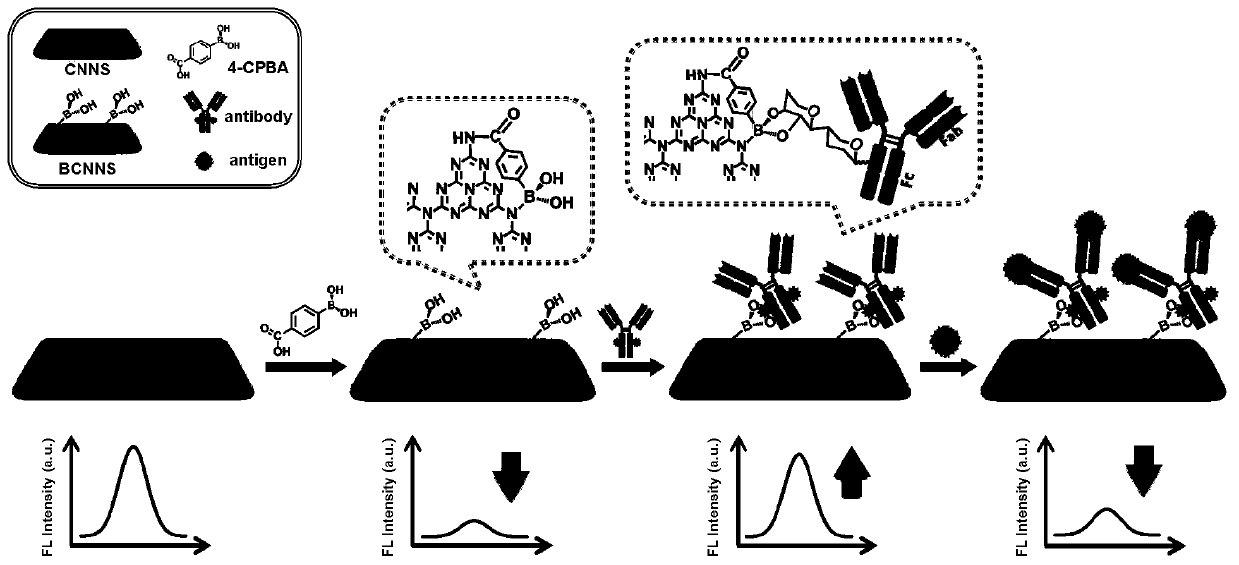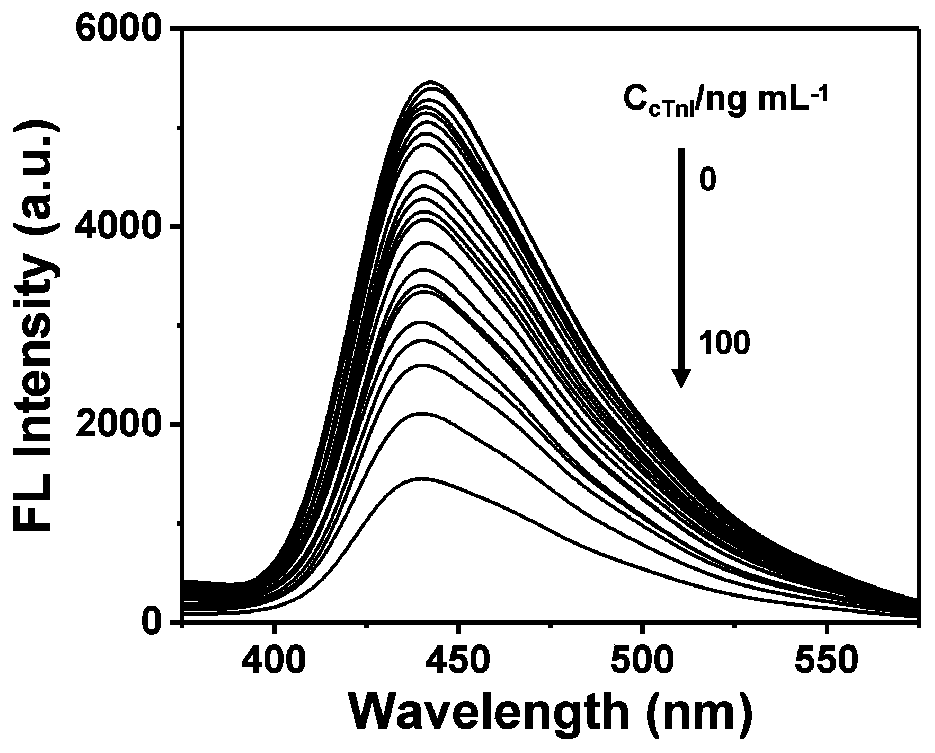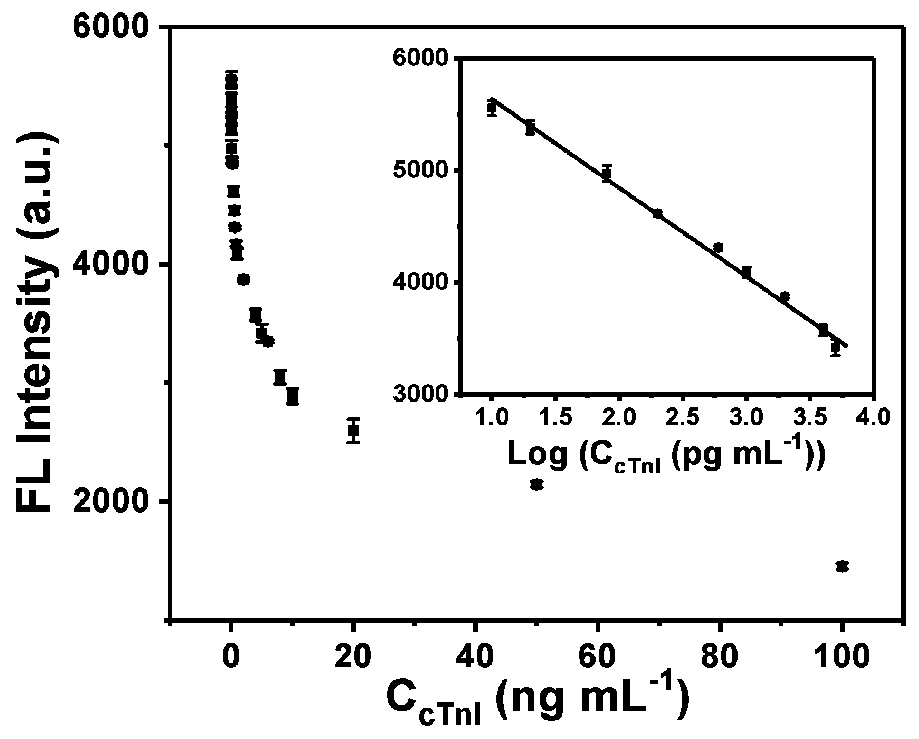Cleaning-free universal ELISA fluorescence immunoassay probe and preparation method and application thereof
A general-purpose technique of fluorescence immunity, which is applied in the field of analysis and testing, can solve problems such as complex chemical reaction mechanisms, and achieve the effects of simple production methods, rapid reactions, and simple and fast detection methods
- Summary
- Abstract
- Description
- Claims
- Application Information
AI Technical Summary
Problems solved by technology
Method used
Image
Examples
Embodiment 1
[0043] A preparation method of a no-clean universal ELISA fluorescent immune probe includes the following steps:
[0044] (1)g-C 3 N 4 Synthesis of powder: Weigh 3g of dicyandiamide into a 50mL alumina crucible, cover it and wrap it with aluminum foil, and put it in a muffle furnace at 3℃min -1 Raise the temperature to 550℃ and keep it for 2h; when the reactant is cooled to room temperature, take it out, the obtained light yellow solid is g-C 3 N 4 , Use an agate mortar to combine the g-C 3 N 4 Grind into uniform solid powder for use;
[0045] (2) Boric acid modification: Take 166 mg of 4-carboxyphenylboronic acid and 400 mg of HBTU in 30 mL of anhydrous DMF, stir to dissolve, and continue to stir at 50°C for 30 minutes to obtain a mixture; then add 100 mg of the mixture to the mixture gC 3 N 4 And 0.5mL DIEA, continue to stir at 50℃ for 12h to complete the reaction; the product after the reaction is collected by centrifugation, and washed 2-3 times with absolute ethanol and seconda...
Embodiment 2
[0050] The method of Example 1 will be used to prepare a no-clean general-purpose ELISA fluorescent immunological probe for the detection of targets with specific antibodies. The specific experiment is to test three myocardial markers in human serum, troponin I (cTnI), Myoglobin (Mb) and creatine kinase isoenzyme MB (CK-MB) were tested.
[0051] 1. Detection of troponin I (cTnI)
[0052] Preparation: The method of Example 1 was used to prepare a no-clean universal ELISA fluorescent immunoprobe Ab using cTnI antibody cTnI -BCNNS.
[0053] Detection methods and results: to Ab cTnI -Directly add cTnI of different concentrations to BCNNS, mix well and incubate in a 37℃ water bath for 20 minutes, and then measure the fluorescence spectrum of the mixture under excitation at 330nm to obtain figure 2 , As can be seen from the figure, as the concentration of cTnI increases (0-100ng mL -1 ), the fluorescence intensity of the system gradually decreases. Record the fluorescence intensity of ...
Embodiment 3
[0067] The method of Example 1 was used to prepare a no-clean universal ELISA fluorescent immunological probe and applied to the detection of cTnI, Mb and CK-MB in human serum.
[0068] Under optimal conditions, to Ab cTnI -BCNNS adds different human serum samples (can be divided into three groups according to negative, low positive, high positive, four samples in each group, a total of 12 samples), measure the fluorescence spectrum of the mixed solution under the same conditions, and record at 440nm And calculate the cTnI content in each human serum sample. At the same time, use the commercial cTnI enzyme-linked immunoassay kit to test the same batch of serum samples. The test value of the cTnI enzyme-linked immunoassay kit for the serum sample is the abscissa, and the test value of the serum sample by the fluorescence immunoassay in this experiment is On the ordinate, the linear correlation diagram of the two methods is obtained ( Picture 12 ), it can be seen from the figure ...
PUM
 Login to View More
Login to View More Abstract
Description
Claims
Application Information
 Login to View More
Login to View More - R&D
- Intellectual Property
- Life Sciences
- Materials
- Tech Scout
- Unparalleled Data Quality
- Higher Quality Content
- 60% Fewer Hallucinations
Browse by: Latest US Patents, China's latest patents, Technical Efficacy Thesaurus, Application Domain, Technology Topic, Popular Technical Reports.
© 2025 PatSnap. All rights reserved.Legal|Privacy policy|Modern Slavery Act Transparency Statement|Sitemap|About US| Contact US: help@patsnap.com



